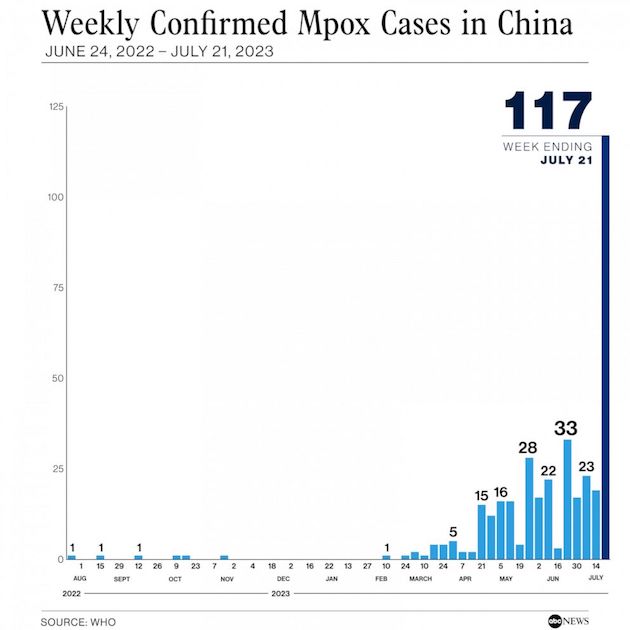While cases of mpox continue to decline across the United States and Europe, infections are steadily rising in China.
For the week ending July 21, 117 cases were confirmed in China, according to data from the World Health Organization. Between the week ending May 5 and the week ending July 21, 315 cases were reported.
This comes after just six cases were confirmed throughout all of 2022, WHO data shows.
Additionally, China had the highest increase in the weekly number of cases during the most recent week of full reporting and cases have risen have more than 50% over the last three weeks, the global health agency said.
“As we know from not only COVID … we only see the tip of the iceberg and we’re not really sure what the true enormity of the issue is,” Dr. Peter-Chin Hong, an infectious disease specialist at the University of California, San Francisco, told ABC News. “Of course, mpox hasn’t gone away and we’ve seen that here. But I think it’s exemplified in places that hadn’t seen a lot of mpox before.
“If you hadn’t seen it before, at some point, it’s going to get there and probably infect people,” he added.
The global mpox outbreak began in the United Kingdom in spring 2022 before spreading throughout Europe and, eventually, to the U.S. At this time, China still had COVID restrictions in place with little travel allowed in and out of the country.
The outbreak was primarily concentrated among gay, bisexual and other men who have sex with men, although the Centers for Disease Control and Prevention has noted that anyone — regardless of sexual orientation — can contract the virus.
After seemingly poised to overwhelm the U.S., the outbreak took a dramatic turn downward. Public health experts have said the combination of people changing their behaviors and a strong vaccination campaign helped beat back the disease.
Despite the WHO declaring the mpox public health emergency over in May 2023, that’s just when cases began rising in Asia, including Japan, Thailand and, most recently, China.
However, case reporting has not been regular in Beijing. The Chinese Centers for Disease Control and Prevention released just one report, last month, documenting 106 cases in June.
No data has been released on any other monthly cases, reminiscent of irregular reporting during the COVID-19 pandemic.
Similarly, there are three vaccines in use around the world to prevent mpox: the Jynneos vaccine (the only one being used in the U.S.), ACAM2000 and Imvanex, although none are approved in China.
“There’s a lot of nationalism in Chinese diagnostics, and vaccines and therapeutics,” Chin-Hong said. “So, China tends to want to use their homegrown stuff. And there’s some early trials for a Chinese mpox vaccines, but there hasn’t really been a lot of outreach, as far we know, to the one factory that makes it which is in Denmark.”
Chin-Hong also added there’s been a lack of urgency to combat the outbreak in China despite the rise in cases. The Chinese CDC only posted a program to prevent and control the spread on July 26, which made mention of a public education program but not of a vaccine campaign.
Chin-Hong added, even though it seems this may not affect the U.S., in today’s closely connected world, diseases can spread quite quickly, as we saw with COVID-19.
“We should care because with these transmissible diseases and globalization of infectious diseases, what happens in China doesn’t only stay in China, even though sure [mpox] is less transmissible,” he said. “So, it can easily find to many places around the world again, and lead to secondary outbreaks. So, anything happening in China, with the world open up again, can affect even more rapidly, other countries.”
Copyright © 2023, ABC Audio. All rights reserved.












